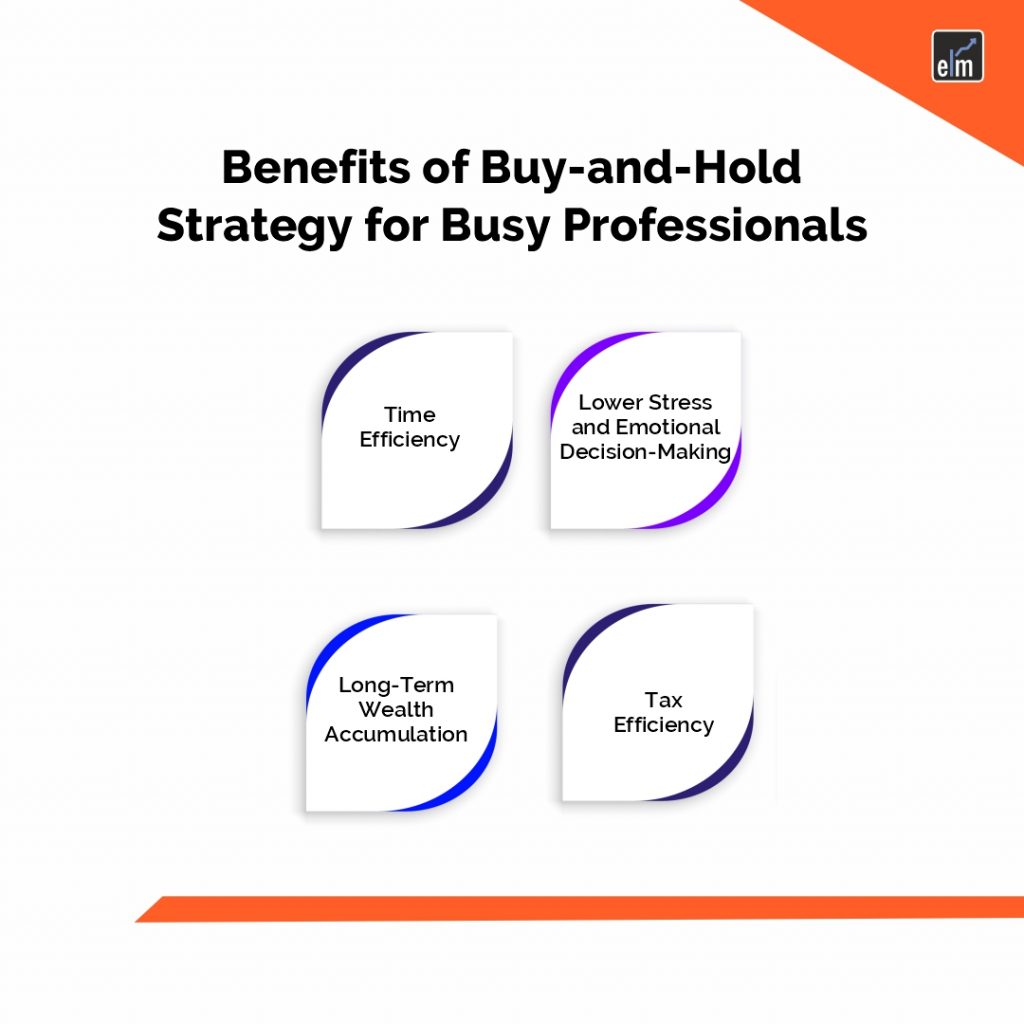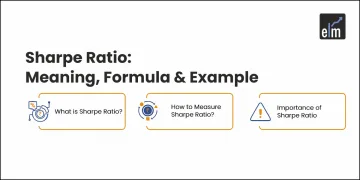Buy-and-Hold Investing is the process of buying assets and holding onto them for a long time, usually years or decades, even in the face of short-term market volatility. It highlights the value of compounding returns and long-term growth.
The Buy-and-Hold strategy is an appealing option for professionals who are busy. This low-maintenance method of accumulating wealth is ideal for those with limited time for active trading.
It fits in nicely with professionals’ busy schedules by lowering the need for continual oversight and decision-making, enabling them to concentrate on their work while gradually accumulating wealth for the future.
A passive investment approach known as “buy and hold” involves an investor purchasing stocks (or other assets, including exchange-traded funds, or ETFs) and holding them for an extended period of time, irrespective of market movements.
A buy-and-hold investor actively chooses their investments; nonetheless, they are unaffected by technical indicators and transient price changes. Several renowned investors, including Jack Bogle and Warren Buffett, recommend the buy-and-hold strategy as the best option for anyone looking for healthy long-term returns.
In today’s blog, let us discuss buy and hold strategy for busy professionals-
Table of Contents
What is a Buy-and-Hold Investing Strategy?
Buy and Hold Investing strategy is buying stocks and hanging onto them for a long time, usually decades or longer, even in the face of short-term market swings.
This strategy is based on the idea that investments should be held for the long term in order to profit from the general market appreciation that occurs over time. The approach places more emphasis on discipline, patience, and basic study than it does on timing the market or trading frequently.
Long-term buy-and-hold investments have traditionally produced high returns; successful investors have amassed substantial wealth by hanging onto high-quality investments over market cycles. Warren Buffett’s long-term investments in businesses like Coca-Cola and Berkshire Hathaway are two examples.
Active trading, in which investors regularly buy and sell stocks in an effort to profit from transient market swings, is in contrast to buy-and-hold investing. In contrast to active traders, buy-and-hold investors generally focus on building long-term wealth rather than chasing quick profits, and they tend to have lower portfolio turnover rates and fewer trading activities overall.
Benefits of Buy-and-Hold Strategy for Busy Professionals
Here are the Benefits of Buy-and-Hold Strategy for Busy Professionals-

1. Time Efficiency
Compared to aggressive trading, buy-and-hold investing needs less time commitment. Working people don’t need to continually watch the markets or make regular financial decisions in order to balance their time between their personal and professional life.
2. Lower Stress and Emotional Decision-Making
Buy-and-Hold investors can steer clear of the emotional turbulence and worry that come with short-term market swings by taking a long-term view. This strategy discourages the propensity to make snap judgments on investments based only on feelings by encouraging discipline and patience.
3. Long-Term Wealth Accumulation
Accumulating wealth over the long term is an aim that buy-and-hold investing nicely fits with. Investors can profit over time from the market’s growth potential and the power of compound returns by hanging onto high-quality investments for extended periods of time.
4. Tax Efficiency
Long-term wealth accumulation is an objective that buy-and-hold investing aligns well with. By holding onto high-quality investments for extended periods of time, investors can eventually benefit from the market’s growth potential and the strength of compound returns.
Getting Started with Buy-and-Hold Investing
Let us discuss the steps for getting started with Buy-and-Hold Investing-

Setting Clear Financial Goals
Clearly defining your financial goals is essential before you start a Buy-and-Hold investing strategy. Think about things like saving for retirement, building wealth, or reaching particular financial goals. Setting objectives aids in choosing the right asset allocation and investing methods for your particular requirements.
Building a Diversified Portfolio
In buy-and-hold investing, diversification is essential for controlling risk and maximizing profits. Invest in a variety of asset classes, including commodities, equities, bonds, and real estate. Think about expanding your diversification within each asset class by making investments across a range of sectors, geographical areas, and firm sizes.
Choosing the Right Investment Vehicles
Choosing appropriate investment vehicles is crucial for putting a successful buy-and-hold strategy into practice. Think about investing in mutual funds, index funds, exchange-traded funds (ETFs), individual equities, and other choices. Select investment vehicles according on your risk tolerance and financial goals, as each one has varying levels of risk, return potential, and liquidity.
Researching and Selecting Investments
To choose the right investments for your portfolio, do extensive study. Consider aspects including the company’s competitive advantages, growth potential, financial stability, and management team. Seek assets with solid foundations and a history of reliable performance over an extended period of time. To assist you in making informed investing selections, you might also consider using Internet resources or speaking with financial consultants.
Strategies for Successful Buy-and-Hold Investing
Here are some strategies for Successful Buy-and-Hold Investing-
Dollar-Cost Averaging
Allocate a predetermined sum of money for recurring investments regardless of the market’s state. By purchasing more shares during periods of low market price and fewer shares during periods of high price, this technique reduces the impact of market volatility and eventually averages out the cost per share over time.
Rebalancing Periodically
To keep the appropriate asset allocation in your portfolio, periodically examine and rebalance it. Rebalancing makes sure that, even when market swings alter the relative values of various assets, your portfolio stays in line with your long-term investing objectives and risk tolerance.
Staying Informed Without Being Overwhelmed
Remain up to date on changes that are pertinent to your assets, as well as market and economic statistics. But try not to let overindulgence in news or passing market noise overwhelm you. Pay close attention to comprehending the underlying principles that guide your investments and their future potential.
Avoiding Market Timing
Resist the temptation to time the market by predicting short-term fluctuations or attempting to buy and sell investments based on market trends. Market timing is notoriously difficult to execute successfully and can lead to missed opportunities and increased trading costs. Instead, maintain a long-term perspective and stick to your investment plan through market ups and downs.
Overcoming Common Challenges
Dealing with Market Volatility
Recognize that fluctuations in the market are common and a necessary aspect of investment. Pay more attention to the investments’ long-term performance than their short-term swings. Invest in a diverse portfolio to lessen the impact of market fluctuations.
Patience and Discipline
Maintain your investing plan with discipline and patience. Steer clear of giving in to fear or greed or responding rashly to changes in the market. Rely on the fundamentals of buy-and-hold investing to stay true to your long-term plan, especially in unpredictable times.
Reassessing and Adjusting Investment Plan
Make sure your investing strategy is in line with your life circumstances, risk tolerance, and financial objectives by reviewing it on a regular basis. Rebalancing your portfolio or reallocating assets are examples of adjustments you should be prepared to make when needed, but do it carefully and on the basis of well-informed analysis rather than hurriedly responding to market movements.
Conclusion
To sum up, buy-and-hold investing provides busy professionals with a dependable way to achieve financial stability and growth even with their hectic schedules. People can focus on their work and slowly accumulate wealth by following the concepts of patience, discipline, and long-term vision. This allows them to handle market volatility with confidence. By employing techniques like as dollar-cost averaging and periodic rebalancing, investors can effectively manage risks and enhance their portfolios for sustained prosperity.
Adopting this strategy promotes educated decision-making, resilience against market volatility, and a stable financial future. The Buy-and-Hold approach is a reliable ally for professionals who are busy starting their investment adventures since it offers long-term wealth and peace of mind.
Frequently Asked Questions (FAQs)
What is Buy-and-Hold Investing?
Buying assets and holding onto them for a long time—regardless of transient market swings—is the essence of investing.
How does Buy-and-Hold Investing benefit busy professionals?
By providing busy professionals with a low-maintenance strategy to wealth generation, buy-and-hold investing enables them to concentrate on their careers while progressively accumulating wealth for the future.
What are the key principles of Buy-and-Hold Investing?
A long-term outlook, diversification, low portfolio turnover, dividend reinvestment, and regular investment reviews are among the fundamental ideas.
For more stock related queries visit StockEdge







